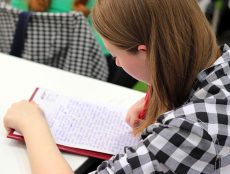
Articles
K-12
Capital Expenditures on Tech and Improvements at Schools Remain 31% Below Pre-Recession: Analysis
By Henry Kronk
August 24, 2019
Capital expenditures—the funds made available to K-12 schools to improve facilities, boost their IT network, and install new technology to improve education in the classroom—took a hit during the Great Recession. States slashed these budgets, along with appropriations for institutions of higher learning, local education employment, general educational spending, and more. An analysis out this week from the left-leaning Center on Budget and Policy Priorities (CBPP) finds that state capital expenditures remain well below pre-recession levels.
Cuts Were Made Across the Board After the Great Recession
In 2008, states collectively spent just under 0.5% of the U.S. gross domestic product on public K-12 school capital expenditures. Spending fell to 0.4% in 2010, and sank below 0.3% between 2013 and 2015.
Cuts also occurred in the fallout of the Great Recession, but they followed a period when GDP shrank by -0.3% in 2008 and -2.8% in 2009.
Since, the U.S. GDP and spending in many states has rebounded. But overall, school capital expenditures remained at just above 0.3% of U.S. GDP in 2017, the latest year for which data is available.
These averages, furthermore, belie the cuts in capital expenditures in certain states. Spending in 38 states remain below 2008 levels, and in some instances, it is far below.
Delaware, Nevada, and even Connecticut—a state whose public school system often ranks among the top five in the U.S. for a variety of measures—have cut their capital expenditures by more than half since 2008.
Arizona and Florida, the severest cases in the country, have brought about capital expenditure cuts of 71% since before the Great Recession.
If Capital Expenditures Don’t Recover, Consequences Will Follow
It’s impossible to say what, exactly, the effects of these cuts will be. But it’s certain that negative outcomes will begin popping up as more and more systems, facilities, technologies, and infrastructures degrade and need repairing.
As Michael Leachman, CBPP’s senior director of state fiscal research, writes in his analysis:
This neglect hurts students’ health and school performance. Research links poor lighting, bad air quality, and noise to lower student achievement. In addition, extreme temperatures resulting from aging heating and cooling systems impede learning and can force school closures that disrupt studies, as Baltimore experienced in the winter of 2018. Already this school year, high temperatures are bringing closures due to lack of air conditioning. Ahigher percentage of public schools in poor areas, which disproportionately educatechildren of color, need repair than those in the wealthiest areas.
What’s more, demands placed on technological infrastructures, devices, and equipment have grown during the same period. The company Funds for Learning helps schools apply for the E-Rate grant, which subsidizes internet services for schools and libraries in the U.S. Each year, they send out a poll among their customers to get a lay of the land. Roughly 1,000 schools responded to their last survey, which represents around 5% of all E-Rate applicants. Among these 64% said they planned to upgrade their Wi-Fi network in the next three years.
“What I also know anecdotally—we represent over 6 million students nationwide—is schools are struggling to keep up, which is a good problem,” said Funds for Learning CEO John Harrington in a previous interview. “They are getting these devices in the hands of students, the teachers are really getting it, they’re clicking, there are all these new tools and resources, and all of a sudden, they need twice the bandwidth.”
Without capital expenditures recovering to pre-2008 levels, however, the task of updating will become far more challenging in the years to come.
Featured Image: Adi Goldstein, Unsplash.









No Comments